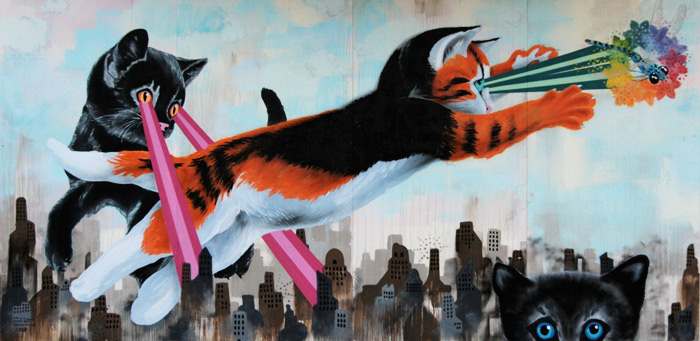Artists Angry Over Replacement of "Kittenzilla" Mural
 I've said it before and I'll say it again, Julianne Yates told us the mural would be up for a minimum of two months, and that whatever the case was, SHE WOULD CONTACT US BEFORE THE NEXT ARTIST WAS READY TO INSTALL - so that we could come and remove our work and relocate it. She is a disgrace to the art world, the quick demise of Henry Gundersons mural seems like it might be some of her curatorial karma biting her in her rear. (with all apologies to Henry Gunderson himself, I found the piece interesting). I wouldn't call it a simple miscommunication, I would call it an overwhelming lack of communication on the part of Julianne Yates altogether.
-- Ezra Eismont
I've said it before and I'll say it again, Julianne Yates told us the mural would be up for a minimum of two months, and that whatever the case was, SHE WOULD CONTACT US BEFORE THE NEXT ARTIST WAS READY TO INSTALL - so that we could come and remove our work and relocate it. She is a disgrace to the art world, the quick demise of Henry Gundersons mural seems like it might be some of her curatorial karma biting her in her rear. (with all apologies to Henry Gunderson himself, I found the piece interesting). I wouldn't call it a simple miscommunication, I would call it an overwhelming lack of communication on the part of Julianne Yates altogether.
-- Ezra Eismont
By Peter Jamison SF Weekly
In mid-November, passersby at Divisadero and Hayes were met with an unlikely sight: a set of enormous kittens beaming lasers from their eyeballs. This was no psychedelic vision shared by teens who had strayed from Haight Street, but a real piece of contemporary art. Dubbed Kittenzilla by the trio of painters who created it, the quirky mural was an overnight hit. Along with plaudits from local bloggers, it was featured in the latest issue of San Francisco magazine.
Yet the kitties, which adorned the side of the vacant Harding Theater, were not long for this world. A few days before Christmas, Kittenzilla was painted over. This wasn't the work of taggers, but an accomplished artist from the East Coast. The story of the cats' demise — and potential resurrection — is an odd tale of crossed signals and shifting allegiances in the city's art world.
Kittenzilla was the work of artists Bunnie Reiss, Ezra Li Eismont, and Garrison Buxton, who were recruited by Gallery Heist to create a mural at the site. Julianne Yates, the gallery's owner, tells SF Weekly she had secured wall spaces for art around the city in honor of the gallery's first anniversary. All of them, she says, were intended to be "rotating walls," with new murals painted over the old ones on approximately a monthly basis.
Yates says this was made clear to Reiss, Esmont, and Buxton — and that she was thus surprised at their outrage when a new artist, Baltimore-based Gaia, began painting a two-headed cow on top of the popular kittens. "I think this whole thing was blown out of proportion," she says. "There was no contract. Nothing was written in stone ... it was just a simple miscommunication."
Reiss says she and her co-artists were under the impression that the mural would stay up for a while, and were put out that they didn't have a chance to remove it — especially because they had purchased the boards fronting the theater on which Kittenzilla was painted. "It just was disgraceful," she says. "It was so sad."
Unlike some other sad stories, however, this one might have a happy ending. Yates says a new painting, by San Francisco artist Henry Gunderson, will soon be up on the wall of the theater. And Reiss says the familiar felines of Kittenzilla might appear in new murals, including one at Albion and Camp in the Mission. "They're sad right now," she says of the cats. "But they're not going to go down in flames like this. They will rise again."